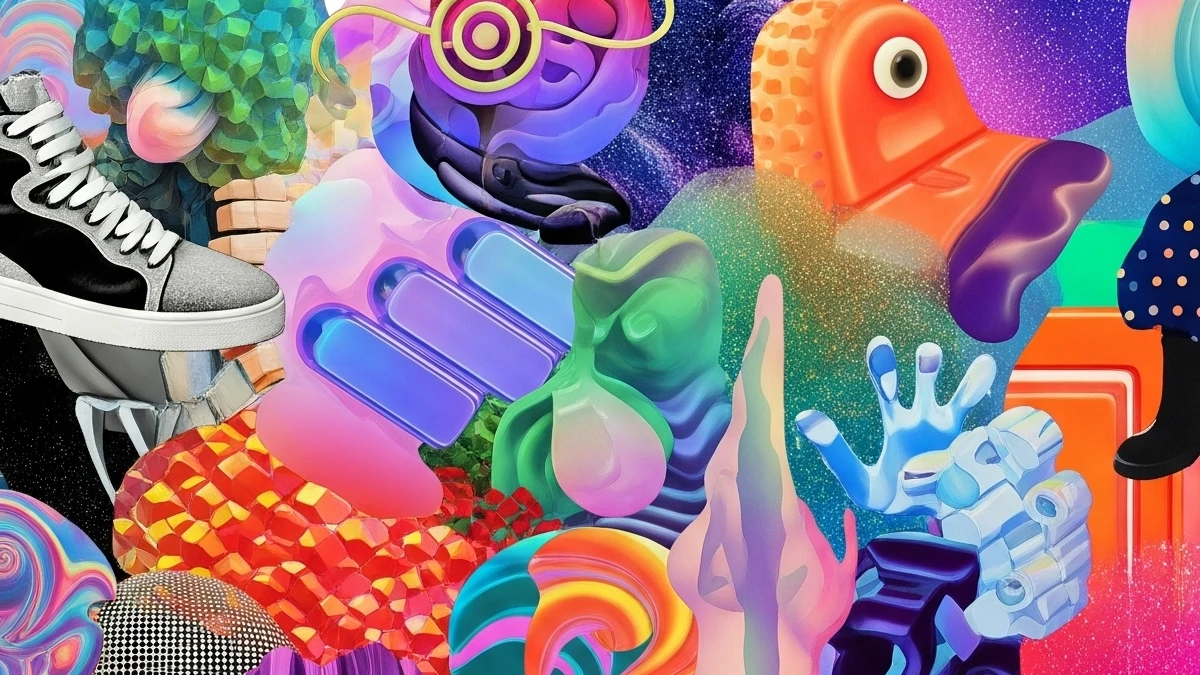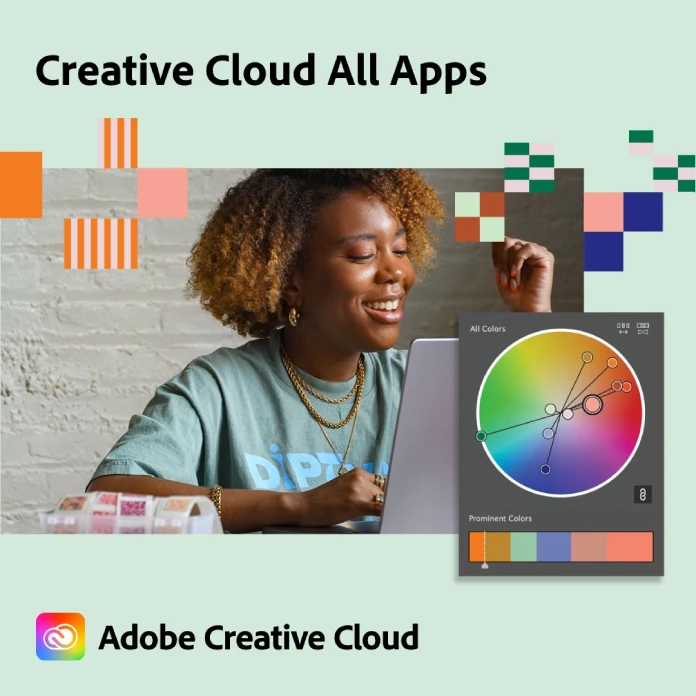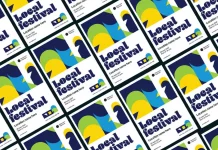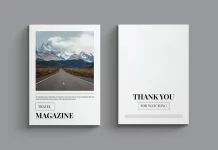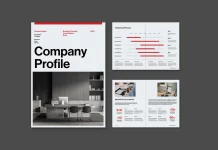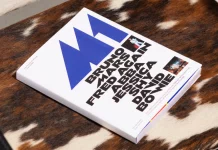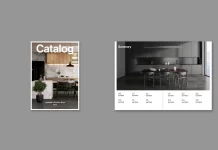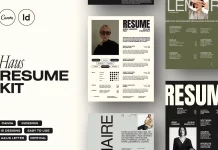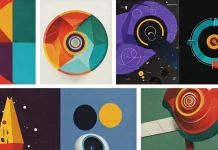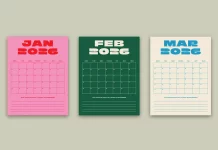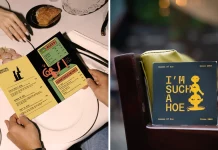This post contains affiliate links. We may earn a commission if you click on them and make a purchase. It’s at no extra cost to you and helps us run this site. Thanks for your support!
Graphic design terms are more than jargon. They describe ideas and processes that shape the way we communicate visually. In recent years, the design world has changed rapidly due to mobile devices, high‑resolution displays, generative AI, and remote collaboration. New concepts appear alongside established principles, and understanding them helps designers, marketers, and clients speak the same language. This lexicon presents hundreds of graphic design terms in alphabetical order. Each entry includes a short description and, where appropriate, critical commentary or context. The aim is to provide a thorough reference that stays readable and engaging. Whether you are a seasoned professional or a curious beginner, this guide will help you navigate the vocabulary that underpins design practice.
Why a Graphic Design Lexicon Matters
Graphic design isn’t just a profession—it’s also a language. If you aren’t familiar with that language, conversations with designers can be bewildering. Terms like bleed, kerning, and knolling mean specific things and influence how a project is executed. Understanding graphic design terms improves collaboration, reduces misunderstandings, and speeds up decision‑making. It also opens up the world of design history, theory, and critique. As technology evolves, new expressions appear: generative typography, variable fonts, and responsive logos. A living lexicon captures both timeless principles and contemporary innovations, ensuring that readers can follow trends while grounding their knowledge in fundamentals.
How to Use This Guide
The lexicon is organized alphabetically. Under each letter, you will find a list of graphic design terms and succinct explanations. Some entries include commentary about why the term matters or how it is applied in practice. Feel free to scroll to a specific letter, explore related terms, or read through the entire alphabet for a broader understanding.
A: Essential Graphic Design Terms
Alignment
Alignment describes how elements are arranged relative to each other. Proper alignment creates order, cohesion, and readability. Designers use left, right, centered or justified alignment to guide the eye and establish hierarchy. Misalignment can convey chaos or energy if used deliberately. When you examine a poster or website, ask yourself: how does alignment influence your perception of order?
Analogous colours
Analogous colors sit next to each other on the color wheel, such as red, orange, and yellow. They create harmony with low contrast, making them popular in branding and illustration. Because analogous palettes evoke subtle moods, they suit projects where continuity and calm are desired. Do you notice how brands like Mastercard use analogous hues to feel cohesive?
Aperture
In typography, an aperture is the opening at the end of an open counter in a letterform. The size of the aperture affects legibility and character. Humanist typefaces tend to have larger apertures, while geometric fonts have tighter openings. Pay attention to apertures when choosing type for interfaces or small text: large openings improve clarity.
Apex
The apex is the top point where two strokes join in a letterform. For example, the apex of the capital “A” influences its style—sharp, blunt, or rounded. Small typographic details like apex shape contribute to a font’s personality. When designing logos or headlines, subtle adjustments to apex angles can make a word feel refined or playful.
Arm
An arm is a horizontal or angled stroke that does not connect to a stem at one end. The term often refers to the top of letters like “E” or “L.” Understanding arms and other stroke components helps when customizing type or drawing lettering, ensuring structural consistency across characters.
Ascender
Ascenders are the parts of lowercase letters, such as b, d, and h, that extend above the x‑height. They affect the texture and rhythm of a line of text. Taller ascenders can make a typeface feel elegant, while shorter ones give a compact appearance. When typesetting body copy, designers balance ascenders and descenders for legibility and aesthetic appeal.
Aspect ratio
Aspect ratio is the proportional relationship between the width and height of a rectangle. Common ratios like 16:9 (HD screens) or 4:3 (older monitors) dictate how images and layouts are formatted. Choosing the right aspect ratio ensures that content scales properly across devices. Have you considered how aspect ratio influences the composition of your social media posts?
Asymmetry
Asymmetry refers to a lack of mirror‑like balance between elements. Rather than being symmetrical, an asymmetrical design places objects in a way that still feels balanced yet dynamic. It creates movement and interest. When used thoughtfully, asymmetry guides the viewer’s eye through the composition and can evoke emotion. Think of a poster where a large image on one side is balanced by smaller text on the other.
Animation
Animation is the process of creating movement by displaying a sequence of images. In modern design, animation ranges from subtle micro‑interactions in user interfaces to complex motion graphics. It can communicate causality, provide feedback, or tell a story. Animations should enhance the user experience rather than distract. Ask yourself: Does the animation support the message, or is it simply decorative?
Artboard
An artboard is the canvas or workspace within design software where you arrange elements. Multiple artboards let designers create different versions or pages. Understanding artboard sizes and exporting settings ensures that your layouts translate correctly across print and digital mediums.
AI‑assisted design
AI‑assisted design describes the use of machine learning to generate layouts, refine typography, or suggest color palettes. Generative tools can accelerate ideation and handle repetitive tasks. However, they do not replace human creativity. Designers must direct and critique AI outputs, ensuring that the final work aligns with the brief and ethical considerations.
B: Building Blocks of Graphic Design Terms
Backslanted text
Backslanted text refers to letters that lean backward. It is the opposite of italic. While rare in body copy, backslanted styles are sometimes used for logos or expressive headlines. Because they push against our reading habits, they attract attention, but should be used sparingly.
Ball terminal
A ball terminal is a round extension at the end of a stroke. Many serif typefaces feature ball terminals on letters like a, c, or y. This detail adds elegance and softens the overall appearance of the font. When designing a logotype, choosing a typeface with ball terminals can make the wordmark feel more organic.
Baseline
The baseline is the invisible line that text rests on. It establishes the reference for measuring ascenders, descenders, and x‑height. Good typography maintains consistent alignment to the baseline, creating a smooth reading experience. Variations from the baseline—such as overshoot in curved letters—compensate for optical effects.
Bitmap
A bitmap is an image composed of pixels arranged in a grid. Photographs and raster graphics are bitmaps. Because bitmaps store color information for each pixel, they can display rich detail but may pixelate when scaled beyond their original dimensions. Contrast this with vector graphics, which define shapes mathematically and scale without loss.
Bleed
Bleed refers to the extra area beyond the trim edge of a printed piece where ink extends. It prevents unwanted white borders when the final product is cut. Designers typically add 3 mm of bleed on each side. If you are creating a flyer or business card, ask yourself: Have you extended your background colors into the bleed area so that the finished piece is seamless?
Body copy
Body copy is the main text in a design. It differs from headlines or captions. Because body copy makes up most of the reading experience, choose a typeface and size that are legible. Pay attention to line length, leading, and contrast to avoid fatigue. Have you ever struggled to read a website because the body copy was too small or the contrast too low?
Bold
Bold is a font weight with thicker strokes than the regular weight. Designers use bold to create emphasis, hierarchy, or contrast. In digital design, accessible bold type can substitute for color when communicating importance. However, overuse of bold dilutes its impact.
Branding
Branding is the strategic process of shaping how a product, service, or organization is perceived. It includes visual elements—logo, color palette, typography—and intangible attributes like tone of voice, values, and customer experience. Effective branding differentiates a company and fosters loyalty. Consider how Nike’s swoosh and “Just Do It” slogan evoke athleticism and empowerment.
Bracket
In typography, a bracket is the curved connection between the stem and serif of some fonts. Bracketed serifs soften the transition between strokes, while unbracketed serifs appear sharp and modern. When choosing a serif typeface, examine whether the serifs are bracketed to match the mood of your project.
Brightness
Brightness refers to the perceived lightness or darkness of a color. It is distinct from saturation (intensity) and hue (color family). Adjusting brightness can create hierarchy and depth in a composition. In user interface design, sufficient brightness contrast between text and background improves readability and accessibility.
Brochure
A brochure is a small booklet or pamphlet used for advertising or information. It often employs folds to organize content. Designing a brochure involves considering paper stock, folding methods, grid systems, and imagery. A well‑designed brochure guides readers through a narrative, often culminating in a call to action.
Burst typography
Burst typography involves letters exploding outward, conveying energy or surprise. It is popular in posters and event graphics. Because burst compositions are highly dynamic, they work best when combined with minimal supporting elements.
C: Color, Composition, and More Graphic Design Terms
Calligraphy
Calligraphy is the art of decorative, expressive handwriting created with specific tools. It values rhythm, contrast, and flourish. Designers often integrate calligraphic elements into invitations, packaging, or logos to convey craftsmanship. Modern calligraphy merges tradition with contemporary styles, reflecting personal expression.
Cap height
Cap height is the height of a capital letter above the baseline. It influences the relationship between uppercase and lowercase characters. When pairing fonts, designers consider matching or contrasting cap heights for harmony. In display type, exaggerating cap height can create drama.
CMYK
CMYK stands for Cyan, Magenta, Yellow, and Key (Black). It is the subtractive color model used in printing. When inks overlap, they create darker tones. Designers convert artwork from the RGB color mode (used for screens) to CMYK for accurate print reproduction. Failing to convert may result in colors that appear muted or off. Before sending files to press, ask yourself: Have you checked your CMYK values to ensure vibrant print results?
Color palette
A color palette is a chosen set of colors for a project. Types include monochromatic, analogous, complementary, split‑complementary, triadic, and tetradic. Palettes shape mood and brand identity. For example, a palette of blues and greens conveys calm and nature, while a palette of red and gold suggests luxury. When selecting a palette, consider cultural meanings and accessibility.
Color theory
Color theory studies how colors interact and affect emotions. It covers concepts like hue, saturation, brightness, contrast, and harmony. Designers use color theory to select palettes that evoke specific feelings and to create focal points. Recognizing how warm colors energize and cool colors soothe helps you match the tone of your message.
Color wheel
The color wheel is a diagram that shows relationships between primary, secondary, and tertiary colors. It helps designers build palettes using analogous, complementary, or triadic schemes. The traditional wheel includes red, blue, and yellow primaries; orange, green, and purple secondaries; and six tertiaries. Familiarity with the color wheel aids in mixing pigments and choosing digital color values.
Complementary colors
Complementary colors sit opposite each other on the color wheel and create strong contrast. Pairing them makes elements pop, which is useful for calls to action or highlighting important information. Examples include red with green, blue with orange and purple with yellow. Be careful: too much complementary contrast can feel jarring; use it strategically.
Contrast
Contrast refers to the difference between two elements. It can be achieved through color, size, weight, shape, or texture. Strong contrast draws attention and defines hierarchy. Without contrast, designs appear flat and confusing. In accessibility, sufficient color contrast ensures that text is readable for people with visual impairments.
Counter
A counter is the enclosed or partially enclosed space within letters such as O, P, R, or a. Closed counters are fully enclosed, while open counters have an opening (as in c or e). Counter size influences legibility: large counters improve readability, while tight counters create a compact look.
Crop marks
Crop marks are lines printed in the corners of a layout to indicate where the paper should be trimmed. They work with bleed to ensure accurate cutting. When exporting print files, enable crop marks so the printer knows where to cut the finished piece.
CSS (Cascading Style Sheets)
CSS is a language used to style HTML content on the web. It defines colors, fonts, layouts, and responsive behavior. Good CSS organization makes websites easier to maintain and ensures consistent branding. Modern CSS features like variables and grid layouts empower designers to create complex, flexible designs without heavy frameworks.
Curvilinear design
Curvilinear design uses flowing, curved lines instead of straight edges. It evokes softness and movement, often seen in organic shapes, logos, and packaging. Combining curvilinear elements with sharp geometric forms can create contrast and tension.
D: Dynamic and Digital Graphic Design Terms
Descender
Descenders are the parts of lowercase letters, such as p, g, and j, that extend below the baseline. They balance ascenders and influence line spacing. Typefaces with long descenders feel elegant but require more vertical space. When designing text within a tight vertical area, choose fonts with shorter descenders.
Depth
Depth creates the illusion of three‑dimensional space in a two‑dimensional design. Techniques include overlapping elements, shadows, gradients, and perspective. Depth guides the viewer’s eye and adds realism. In user interfaces, subtle elevation differences inform users about interactive elements.
Design system
A design system is a comprehensive collection of reusable components, guidelines, and standards that ensure consistency across products. Companies like Google and IBM publish design systems to coordinate teams. Implementing a design system improves efficiency and coherence. Have you considered how a well‑documented system could simplify your workflow?
DPI (Dots per Inch)
DPI measures the resolution of printed images. Higher DPI values produce finer detail. When preparing print artwork, designers typically aim for 300 DPI. On the web, PPI (pixels per inch) is more relevant. Ensuring the proper resolution avoids blurry output.
Drop cap
A drop cap is a large initial letter that drops below the baseline of the first line of a paragraph. It draws attention and adds a decorative element. Drop caps appear in magazines and books to signal the start of a section.
Dummy text
Dummy text, such as Lorem ipsum, is placeholder copy used to simulate real content in a layout. It allows designers to focus on aesthetics without being distracted by unfinished copy. However, dummy text should be replaced with meaningful content before final approval, as real text often changes the flow and spacing.
E: Expression and Execution Graphic Design Terms
Embossing
Embossing creates a raised or depressed relief on a surface, adding tactile and visual depth. Used on business cards and packaging, embossing elevates perceived quality. Debossing presses the design into the material, achieving the opposite effect.
Emphasis
Emphasis draws attention to a specific element. It is achieved through size, color, contrast, or placement. Effective emphasis guides the viewer’s journey through a composition and supports narrative flow.
Ergonomics
Ergonomics in design concerns the comfort and safety of users when interacting with products. For graphic designers, ergonomics informs workspace layout and equipment choices. For user interface designers, it guides the placement and size of buttons and controls.
Eyeline
The eyeline is the path that a viewer’s gaze naturally follows when looking at a design. Understanding eyeline helps designers position focal points and create effective layouts. Leading the eye through a composition enhances storytelling.
Extended typeface family
An extended typeface family includes multiple weights, widths, and styles, allowing for flexible hierarchy and tone. Using an extended family ensures consistency across headings, body copy, and captions while providing variety.
F: Form and Function Graphic Design Terms
Flat design
Flat design is a minimalist aesthetic featuring crisp edges, bold colors, and simple typography. It eschews the textures and shadows of skeuomorphism, favoring clarity and efficiency. Popularised by digital interfaces, flat design improves loading speed and readability. However, an overly flat interface can feel lifeless; designers often add subtle motion or gradients for depth.
Flow
Flow describes the smooth movement of a viewer’s eye through a design. Achieving flow involves aligning elements, establishing hierarchy and balancing negative space. Good flow keeps readers engaged and prevents confusion.
Font weight
Font weight refers to the thickness of characters in a typeface. Weights range from thin to extra bold. Using different weights within a family helps to establish hierarchy without switching typefaces. For accessible design, heavier weights improve legibility at small sizes.
Framing
Framing involves positioning elements within borders or shapes to create focus. Frames can be literal borders or implied boundaries formed by color blocks or negative space. Effective framing isolates important content and adds structure.
Grid
A grid is an underlying structure of columns and rows used to align elements. Grids provide consistency and make complex layouts manageable. Breaking the grid intentionally can create tension or highlight key elements. Do you notice when a design uses a strict grid versus a loose one?
Gradient
A gradient is a gradual transition between colors. Gradients can add depth, create mood, and draw attention. They appear in backgrounds, logos, and buttons. Current trends favor subtle linear gradients, but radial and conic gradients offer unique alternatives.
Golden ratio
The golden ratio is a mathematical ratio found in nature that designers use to create balanced compositions. It approximates 1:1.618 and is related to the Fibonacci sequence. Artists and architects have used the golden ratio for centuries. In design, applying this ratio to layout widths or image cropping yields pleasing proportions.
Gutter
In publishing, the gutter is the space between facing pages in a book or magazine. Accounting for the gutter prevents important content from being lost in the binding. In multi‑column layouts, gutters are the spaces between columns; adjusting them changes the reading experience.
H: Hierarchy and Harmony Graphic Design Terms
Hand lettering
Hand lettering is the art of drawing letters by hand. Unlike calligraphy, which uses fluid strokes, hand lettering often builds letters from basic shapes, adding embellishments and shading. It allows for customized wordmarks and expressive compositions.
Harmony
Harmony refers to the pleasing arrangement of elements that creates a sense of unity. It can be achieved through consistent color palettes, similar shapes, or recurring motifs. Without harmony, designs may feel disjointed.
Hex code
A hex code is a six‑digit hexadecimal number representing a color. Web designers use hex codes to specify precise hues. For example, #FF5733 corresponds to a particular orange. Understanding hex codes enables accurate color translation between digital and print media.
Hierarchy
Hierarchy is the organization of elements according to importance. It guides viewers through content. Hierarchy emerges through scale, color, weight, and position. Without a clear hierarchy, readers struggle to navigate and absorb information.
Hue
Hue refers to the pure spectral colors—red, orange, yellow, green, blue, and violet. Saturating or tinting a hue produces new shades and tones. Identifying hues helps in selecting complementary or analogous color combinations.
Human-centered
Human-centered design puts people’s needs, behaviors, and contexts at the core of the creative process. Designers engage with users, empathize with their challenges, and prototype solutions iteratively. This approach underpins modern UX design.
I: Innovation and Interaction Graphic Design Terms
Iconography
Iconography is the visual representation of concepts through icons. Effective iconography simplifies complex ideas into recognizable symbols. A consistent icon set enhances usability and brand identity. When designing icons, consider line weight, style, and metaphor clarity.
Illustration
Illustration involves creating images to accompany text or convey ideas. Illustrations range from hand‑drawn artwork to vector graphics. They can explain concepts, evoke emotions, or reinforce storytelling. Styles include realism, minimalism, geometric, and abstract.
Infographic
An infographic communicates information through a combination of images, charts, and text. Good infographics simplify data without oversimplifying, using hierarchy and contrast to guide readers. When designing one, ask yourself: Does the visual aid help the audience understand the data better than plain text would?
Inker
An inker is a person who traces and refines pencil sketches with ink. Inking clarifies linework, defines weight, and prepares artwork for reproduction. Digital inking tools mimic traditional pens and brushes, giving artists control over pressure and texture.
Interface design
Interface design focuses on the layout and interactions of software applications. It encompasses visual elements and usability. Principles like consistency, feedback, and affordance ensure that users can navigate interfaces intuitively.
J: Juxtaposition and Justification Graphic Design Terms
Justified text
Justified text aligns to both the left and right margins, creating a clean block. It is common in newspapers and books. However, excessive justification can introduce uneven spacing between words. Adjusting hyphenation and tracking helps improve the appearance.
JPEG
JPEG is a compressed image file format widely used for photographs and web graphics. It balances quality and file size through adjustable compression. Note that JPEG uses lossy compression, meaning repeated edits and saves degrade image quality. For logos or illustrations, prefer lossless formats like PNG or SVG.
K: Kerning and Knolling Graphic Design Terms
Kerning
Kerning is the process of adjusting the spacing between specific characters. Proper kerning eliminates awkward gaps, creating even rhythm. Automatic kerning algorithms in design software work well for body text, but headlines often require manual adjustments. When creating a logotype, carefully kern each letter pair to achieve balance.
Key colour
A key color is the dominant hue in a design. It sets the mood and anchors the palette. Choosing a key color requires considering brand values, cultural associations, and contrast with other colors.
Knolling
Knolling is a photography and layout technique where objects are arranged at right angles and photographed from above. It creates an organized, symmetrical look. Designers use knolling to present tools, ingredients, or products aesthetically. Try arranging your workspace items neatly and capturing a flat‑lay image to experience the satisfying order of knolling.
L: Layout and Letterforms Graphic Design Terms
Leading
Leading (pronounced “ledding”) is the vertical space between lines of text. Adequate leading improves readability, while tight leading makes text feel cramped. Conversely, too much space disrupts cohesion. When setting paragraphs, adjust leading according to the font size and line length to maintain comfortable reading.
Legibility
Legibility describes how easily one can distinguish individual letters. Factors influencing legibility include typeface design, x‑height, stroke contrast, and letter spacing. High legibility is crucial for small text or long reading sessions.
Lorem ipsum
Lorem ipsum is dummy text used as a placeholder in layouts. It allows designers to focus on visual hierarchy without final copy. However, relying on Latin filler can mask issues with copy length or language. Use real content early in the process to test the design’s adaptability.
Low‑poly art
Low‑poly art uses polygonal shapes with relatively few facets. It originated in early 3D graphics and now appears in posters, video games, and branding. The faceted look conveys modernity and abstraction.
Logo lockup
A logo lockup is a specific arrangement of the logo symbol and logotype. Brands create lockups for horizontal, stacked or icon‑only usage. Consistent lockups ensure brand recognition across applications.
M: Modern and Multimedia Graphic Design Terms
Margins
Margins are the blank spaces around the edges of a layout. Appropriate margins create breathing room and prevent content from feeling crowded. In print design, margins accommodate binding and allow the design to “breathe.” On screen, responsive margins adapt to various viewport sizes.
Masking
Masking hides parts of an image or shape using another shape as a mask. It allows designers to reveal only certain areas of content. Creative masking can add interest and focus.
Masthead
A masthead is the graphic title found at the top of a printed or digital page. In magazines, it includes the publication’s name, date, and sometimes issue number. Designing a masthead requires balancing legibility with personality.
Mock‑up
A mock‑up is a realistic representation of a design in context. It helps clients visualize how a logo appears on stationery or how a website looks on a smartphone. Creating high‑quality mock‑ups enhances presentations and decision‑making.
Mood board
A mood board is a collage of images, colors, typography, and textures that convey the desired mood of a project. It helps align stakeholders on a creative direction before detailed design begins.
Monochrome
A monochrome palette uses various shades and tints of a single hue. It creates harmony and simplicity. For example, a monochrome red palette ranges from deep burgundy to pale pink. Monochrome designs often rely on contrast in tone and texture rather than color.
Motion graphics
Motion graphics combine graphic design with animation and sound. They are used in video, film titles, advertisements, and explainer videos. A strong grasp of timing, pacing, and narrative is essential for compelling motion graphics.
Multipage layout
A multipage layout involves designing several pages that flow coherently. Books, magazines, and reports require consistent grids, headers, footers, and page numbers. Effective multipage design guides the reader through sections while maintaining visual interest.
N: Negative Space and New Media Graphic Design Terms
Negative space
Negative space, also called white space, is the area around and between design elements. It allows the layout to breathe and can form hidden shapes (like the arrow in the FedEx logo). Treat negative space as an active design element rather than an empty background.
Neon colours
Neon colors are bright, saturated hues reminiscent of fluorescent lights. They attract attention and convey energy. Neon palettes are popular in retro and cyberpunk aesthetics, but can overwhelm if overused.
Neumorphism
Neumorphism is a design trend blending skeuomorphism and flat design. It uses subtle shadows and highlights to create soft, extruded surfaces. Because neumorphism relies on low contrast, it poses accessibility challenges. Use it sparingly and always test for sufficient contrast.
Node
In vector graphics, a node is a point that defines the shape of a path. Editing nodes changes curves and angles. Mastery of node manipulation is crucial for drawing smooth vector illustrations.
Non‑destructive editing
Non‑destructive editing preserves original content by applying adjustments in layers or through masks. It allows designers to experiment without permanently altering the source. Tools like adjustment layers in Photoshop exemplify non‑destructive workflows.
O: Objects and Ornaments Graphic Design Terms
Oblique
Oblique type is slanted to the right, similar to italics but without the structural changes. Many sans‑serif typefaces offer oblique variants instead of true italics. Use oblique style for emphasis while maintaining the same basic letterforms.
Opacity
Opacity measures a color’s transparency. Lower opacity reveals what lies behind, while higher opacity obscures underlying layers. Adjusting opacity creates layering effects, softens backgrounds, or emphasizes foreground elements.
Orphan
In typesetting, an orphan is the first line of a paragraph that appears alone at the bottom of a column or page. Avoid orphans by adjusting copy or manual line breaks to keep related sentences together.
Outline font
An outline font is a typeface designed with only the strokes, leaving the interior transparent. Outline fonts add a graphic flair and work well at large sizes. They can be combined with solid text for contrast.
P: Print and Pixels Graphic Design Terms
Palette knife typography
Palette knife typography involves creating letters using a palette knife and paint. It combines abstract textures with legible forms. This tactile approach suits posters, album covers, and editorial spreads.
Pantone
Pantone is a standardized color-matching system that identifies specific hues with numerical codes. Designers and printers use Pantone swatches to ensure consistent color reproduction across different media. When accuracy is critical—such as in a brand’s signature color—specifying a Pantone number eliminates guesswork.
Pixel
A pixel (picture element) is the smallest unit of a digital image. Screens display millions of pixels, each representing a color. Pixel density affects image sharpness. When creating icons or UI elements, align designs to pixel grids to avoid blurry edges.
Placeholder image
A placeholder image temporarily fills a space in a layout until the final image is available. Like dummy text, placeholder images help visualize composition but must be replaced with relevant content.
Print resolution
Print resolution determines the level of detail in printed images. Measured in DPI, higher resolutions produce sharper results but require larger files. For high‑quality art prints, designers may go beyond 300 DPI.
Prototype
A prototype is an early model of a design used to test functionality and user experience. Prototypes range from paper sketches to fully interactive digital simulations. They allow teams to validate ideas and gather feedback before development.
PPI (Pixels Per Inch)
PPI describes the pixel density of a digital display. High‑PPI screens render text and images more crisply. When exporting assets, supply multiple resolutions to accommodate devices with different PPI values.
Pull quote
A pull quote is an excerpt pulled from body copy and displayed in a larger type size. It highlights key messages and breaks up long text. Pull quotes should be set apart with distinctive typography or color to attract readers.
Q: Quality and Quirk Graphic Design Terms
QR code
A QR code is a two‑dimensional barcode that stores information encoded as black and white squares. Designers incorporate QR codes into print materials to link to websites, contact information, or interactive content. When adding a QR code, ensure sufficient contrast and quiet space around it for reliable scanning.
Quadrant layout
A quadrant layout divides the page into four equal sections. Each quadrant can hold an image, a block of text, or a graphic. The approach creates order and helps compare related items. Quadrant layouts are useful in brochures and infographics.
Quotation marks
Quotation marks indicate direct speech or citations. In typography, choose smart quotes (“ ”) instead of straight quotes (‘ ‘). Pay attention to language conventions: some languages use different quotation mark shapes and placements.
R: Rules, Resolution, and Rhythm Graphic Design Terms
Radial balance
Radial balance arranges elements around a central point. The design radiates outward like spokes on a wheel. This approach draws focus to the center and works well for logos, mandalas, and diagrams.
Raster image
A raster image is another term for a bitmap. It consists of pixels and is resolution-dependent. Raster images are ideal for photographs but should not be scaled beyond their native resolution.
Responsive design
Responsive design ensures that a website adapts seamlessly to different screen sizes. It involves flexible grids, images, and CSS media queries. A responsive layout improves user experience across desktops, tablets, and smartphones.
RGB
RGB stands for Red, Green, and Blue—the additive color model used for digital displays. In RGB, colors become brighter as light is added. Converting from RGB to CMYK before printing ensures accurate reproduction.
Rule of thirds
The rule of thirds divides an image into nine equal parts using two horizontal and two vertical lines. Placing focal points along these lines or at their intersections creates balanced compositions. Photographers and designers apply the rule of thirds to guide viewers’ attention.
Rhythm
Rhythm is a visual beat created by repeating elements with variation. Like music, rhythm can be steady or unpredictable. Repetition, pattern, and spacing generate rhythm, influencing how the viewer experiences the design.
Rough
A rough is a preliminary sketch or layout presented to clients before final artwork. It conveys composition and concept without refined details. Presenting roughs early saves time and encourages feedback.
S: Shape, Scale, and Style Graphic Design Terms
Saturation
Saturation describes the intensity of a color. High saturation yields vivid, pure colors; low saturation produces muted, grayish tones. Adjusting saturation controls mood: desaturated images feel vintage or subdued, while saturated palettes appear lively.
Scale
Scale refers to the relative size of elements. Using large and small elements together creates hierarchy and interest. Dramatic shifts in scale can draw attention and convey importance. When designing posters, ask: which element should be the largest to anchor the composition?
Serif
A serif is the small projection at the end of a stroke in a letter. Serif typefaces, such as Times New Roman and Garamond, have these terminals, while sans‑serif typefaces do not. Serifs aid readability in printed body copy and convey traditional or formal qualities.
Skeuomorphism
Skeuomorphism is a design style that mimics real‑world objects. Early digital interfaces used skeuomorphic icons to make technology familiar—for example, a trash‑can icon for deleting files. Modern design often favors minimalism, but skeuomorphic cues can aid usability when introducing new concepts.
Smart guides
Smart guides are visual aids in design software that help align and distribute objects. They appear as you move elements, snapping them into alignment with other objects or the artboard. Using smart guides speeds up layout tasks and ensures precision.
Style guide
A style guide is a document outlining the visual and editorial standards for a brand or project. It includes logos, typography, color palettes, and tone of voice. A well‑maintained style guide ensures consistency across teams and channels.
SVG (Scalable Vector Graphics)
SVG is an XML‑based file format for vector graphics. SVGs scale to any size without losing quality, making them ideal for logos, icons, and illustrations on the web. They can also include animations and interactivity through CSS and JavaScript.
Symbol
A symbol is a simplified representation of an idea or object. In branding, a symbol can stand alone as a logo mark. Designing an effective symbol requires distilling complex concepts into an instantly recognizable form.
T: Typography and Texture Graphic Design Terms
Template
A template is a pre‑designed layout that serves as a starting point for a project. Templates speed up production and ensure consistency. Customizing templates requires understanding underlying grids and typography to avoid generic results.
Texture
Texture refers to the surface quality of an element. It can be visual (implied through patterns and shading) or physical (in print materials like letterpress paper). Adding texture enriches designs, but too many textures can clutter compositions.
Tint
A tint is a pure hue with white added. Tints create lighter, pastel versions of colors. Using tints extends a palette without introducing new hues and helps build hierarchy.
Tracking
Tracking adjusts the uniform spacing between characters in a block of text. Tight tracking condenses text, while loose tracking opens it up. Adjust tracking carefully: too tight reduces legibility, too loose appears scattered.
Triadic color scheme
A triadic color scheme uses three colors evenly spaced around the color wheel. It offers vibrant contrast while maintaining harmony. Typically, one color dominates, another supports, and the third accents. Triadic schemes require balancing saturation and proportion.
Typography
Typography is the art and technique of arranging type. It encompasses typeface selection, point size, line length, line spacing, letter spacing, and more. Good typography communicates content clearly and evokes the right mood. Studying typography teaches you to appreciate subtle decisions that make reading pleasurable.
Typeface
A typeface is a family of related fonts sharing common design traits. For instance, Helvetica is a typeface with weights like regular, bold, and italic. Choosing the right typeface involves considering personality, legibility, and suitability for the medium. Do you select typefaces that match the tone of your message?
Typesetting
Typesetting is the process of arranging type on a page or screen. It involves balancing hierarchy, spacing, and alignment. Professional typesetters refine details like hyphenation, ligatures, and optical margin alignment to produce polished results.
U: Usability and UX Graphic Design Terms
UI (User Interface)
UI refers to the visual and interactive elements through which users interact with a digital product. UI design involves layout, color, typography, and controls. A well‑designed UI makes applications intuitive and enjoyable.
Underline
An underline is a horizontal line beneath text. It can indicate emphasis or a hyperlink. In print, underlining is rarely used due to its effect on legibility. On the web, underlines help users recognize clickable links.
UX (User Experience)
UX encompasses all aspects of how a person interacts with a product or service. UX designers consider user needs, workflows, and emotions. The goal is to create experiences that are efficient, satisfying, and accessible.
Uppercase
Uppercase letters are capital letters. Using uppercase for headings can convey authority or urgency. In long passages, uppercase text is harder to read because words lose their familiar shapes.
Usability testing
Usability testing involves observing real users interacting with a prototype or product to identify issues. Insights from testing inform iterative improvements. Running usability tests early and often prevents costly redesigns later.
V: Vector and Visual Identity Graphic Design Terms
Vector graphics
Vector graphics define images with mathematical equations rather than pixels. They scale infinitely without quality loss. Designers use vector formats (e.g., SVG, EPS, AI) for logos, icons, and illustrations. Familiarity with vector software like Illustrator or Affinity Designer is essential for graphic design.
Vernacular typography
Vernacular typography refers to everyday lettering found in signage, packaging, and street art. Studying vernacular type provides inspiration and insights into local culture. Designers may incorporate vernacular elements into their work to add authenticity.
Visual hierarchy
Visual hierarchy organizes elements so that viewers perceive them in a deliberate order. Using size, color, contrast, and positioning, designers guide attention from the most important to the least important information. Without hierarchy, designs feel chaotic and ineffective.
Visual identity
Visual identity is the visual language that represents a brand. It includes logo, color scheme, typography, imagery, and graphic elements. A strong visual identity communicates brand values and builds recognition across touchpoints.
Vitruvian principles
Vitruvian principles originate from the Roman architect Vitruvius, who championed firmness, commodity, and delight in architecture. Designers apply similar principles—durability, functionality, and beauty—to create work that stands the test of time.
W: Web, Warm Colors, and Whitespace Graphic Design Terms
Warm colours
Warm colors, such as red, orange, and yellow, evoke energy and warmth. They advance visually, making them suitable for calls to action. Pair warm colors with cool ones to create contrast and balance.
Web typography
Web typography adapts typographic principles to digital environments. It accounts for variable screen sizes, responsive behavior and legibility across devices. Choosing web‑safe fonts or loading custom fonts responsibly influences performance and user experience.
White space
White space refers to empty areas in a design. It isn’t necessarily white; rather, it’s any unmarked space. White space improves readability, highlights content, and makes compositions feel elegant. Resist the urge to fill every inch; instead, let elements breathe.
Wireframe
A wireframe is a low‑fidelity blueprint of a website or application. It outlines structure, content placement, and user flows without focusing on aesthetics. Wireframes help teams align on layout before committing to detailed design.
Wordmark
A wordmark is a logo consisting solely of the name of the company rendered in a distinctive typeface. Famous examples include Google and Coca‑Cola. Designing a successful wordmark requires typographic finesse and attention to letter spacing.
Workflow
Workflow refers to the sequence of steps taken to complete a project. A clear workflow improves efficiency and reduces errors. Documenting workflows—especially in collaborative environments—ensures everyone follows the same process.
X: X‑Height and Experimental Graphic Design Terms
X‑height
X‑height is the height of lowercase letters, specifically the letter x, excluding ascenders and descenders. It affects legibility and apparent size. Typefaces with large x‑heights appear bigger and more readable at small sizes; those with small x‑heights feel elegant but may require larger point sizes.
Xerography
Xerography is a dry photocopying process invented by Chester Carlson. Its aesthetics—grainy textures and high contrast—have inspired graphic designers, particularly in punk and zine cultures. Xerographic effects add grit and analog charm to digital compositions.
XOR blending mode
In digital design, XOR (exclusive or) is a blending mode that inverts colors where layers overlap. It creates unexpected, high‑contrast effects and is occasionally used in glitch art and experimental typography.
Y: Yellowing and YAML Graphic Design Terms
Yellowing
Yellowing refers to the gradual discoloration of paper caused by aging or exposure to light and acid. Understanding yellowing helps book and print designers choose archival materials and protective coatings.
YAML (YAML Ain’t Markup Language)
YAML is a human‑readable data serialization format commonly used for configuration files. Designers working with front‑end frameworks may encounter YAML when managing project settings or component libraries.
Y‑axis
The Y‑axis is the vertical axis in a coordinate system. In design software, understanding axes helps with alignment, rotation, and animation. When animating elements, controlling movement along the Y‑axis changes vertical position.
Z: Zenith and Z‑Order Graphic Design Terms
Zen principle in design
Zen principles emphasize simplicity, balance, and mindfulness. Applying Zen to design means removing unnecessary elements, focusing on clarity, and embracing negative space. A Zen‑inspired layout feels calm and purposeful.
Z‑order
Z‑order is the stacking order of overlapping objects in design software. Items with higher z‑order appear in front of those with lower values. Understanding z‑order ensures that elements layer correctly, preventing hidden or obscured content.
Zoomorphic design
Zoomorphic design incorporates animal forms or motifs into products or graphics. Using zoomorphism adds character and plays on cultural associations with certain animals—strength, agility, or wisdom.
Z‑pattern layout
A Z‑pattern layout guides the reader’s eye in a Z‑shaped path across the page: from top left to top right, then diagonally down to bottom left, and finally across to bottom right. This pattern reflects how Western readers scan content and is common in advertising and web design.
Extended Lexicon: Additional Graphic Design Terms
The lexicon above covers major concepts, but design is far richer. Professional designers use many additional terms to describe materials, techniques, and emerging technologies. The following section expands the glossary with more specialized vocabulary. Each term is arranged alphabetically and explained clearly, with notes on why it matters.
A Terms
Achromatic – A design that lacks color, using only black, white, and grey. Achromatic palettes emphasize form, contrast, and tonality. They are common in minimalist layouts or corporate documents where color might distract from the message.
Additive color – A color model where red, green, and blue light combine to create other colors. Digital displays rely on additive color, so understanding it helps designers adjust brightness, saturation, and white balance. Mixing all three primaries at full intensity produces white.
Artisan printing – Small-scale or craft-oriented printing that prioritizes quality, materiality, and individuality over volume. Designers collaborate with artisans to create unique textures, letterpress impressions, or hand-bound books. Artisan printing appeals to luxury brands and collectors.
B Terms
Baseline grid – A horizontal grid that aligns type across columns and pages. Using a baseline grid ensures consistent spacing between lines of text. It also helps align images and icons with text, creating a sense of rhythm.
Bezier curve – A mathematically defined curve used in vector graphics. Each curve is controlled by anchor points and handles. Mastering Bezier curves allows designers to create smooth, precise shapes in logos, icons, and illustrations.
Brand architecture – The hierarchical structure that organizes a brand’s portfolio. It defines how sub-brands relate to the parent brand. Clear brand architecture guides identity design, naming, and visual systems across products and services.
C Terms
Cliché – A design element or motif that has become overused to the point of losing impact. Avoiding clichés encourages originality and prevents work from feeling derivative. Recognizing them helps designers push beyond predictable solutions.
Coated paper – Paper with a clay or polymer coating that gives it a smooth, glossy surface. Coated paper improves colour reproduction and sharpness. It is popular for magazines, brochures, and packaging where vibrant imagery matters.
Cutline – A caption or brief description placed under a photograph or illustration. Good cutlines add context, credit the source and enhance reader understanding without repeating obvious information.
D Terms
Debossing – A printing technique where a design is pressed into a material to create an indented impression. Debossing adds tactile interest to business cards, book covers, and packaging. It contrasts with embossing, which raises the design.
Digital asset management (DAM) – Software and processes for organizing, storing, and distributing digital assets such as images, videos and design files. A robust DAM system streamlines workflows, ensures version control, and protects intellectual property.
Dot gain – The tendency of printed ink dots to spread on paper, making colors darker and less sharp. Designers account for dot gain by adjusting color profiles and ink densities before sending files to press.
E Terms
Editorial design – The practice of designing magazines, newspapers, and long-form publications. It balances typography, imagery, and grid systems to create engaging narratives. Editorial design also includes digital publications and interactive magazines.
EPS (Encapsulated PostScript) – A vector file format widely used for logos and illustrations. EPS files retain scalability and can include both vector and bitmap data. They are compatible with many design programs and printers.
Environmental design – Also known as experiential graphic design, it involves designing signage, wayfinding systems, and branded environments. Environmental design shapes how people navigate public spaces and influences their perception of a brand or institution.
F Terms
Favicon – A small icon associated with a website, typically displayed in browser tabs and bookmarks. A well-designed favicon reinforces brand identity and improves user experience by making a site easier to recognize.
Foil stamping – A process that applies metallic or pigmented foil to a surface using heat and pressure. Foil stamping adds luxurious shine and can be used on business cards, invitations, and packaging.
Front-end design – The visual and interactive aspects of a website or application that users see. Front-end designers work with HTML, CSS, and JavaScript to translate static designs into responsive interfaces.
G Terms
Gamut – The complete range of colors that a device or medium can reproduce. Understanding gamut helps designers choose appropriate color profiles for print and digital work. Some colors visible on screen cannot be printed, and vice versa.
Glitch art – A style that embraces digital errors such as pixelation, distortion, and data corruption. Glitch art challenges notions of perfection and can evoke a sense of nostalgia or chaos. Designers use glitch techniques to create experimental visuals.
Golden spiral – A spiral that conforms to the golden ratio and appears in nature. Designers overlay golden spirals on compositions to guide the viewer’s eye and create harmonious proportions.
H Terms
Hard light – A lighting condition with strong, direct illumination that produces sharp shadows. In photography and rendering, hard light highlights texture and contrast. Designers consider light qualities when selecting reference imagery or creating 3D scenes.
Hero image – A large, prominent visual placed at the top of a webpage or layout. Hero images capture attention and set the tone for the content that follows. They often combine a striking photograph with minimal text.
Hue rotation – A digital adjustment that shifts all colors in an image around the color wheel. Hue rotation can create unexpected color schemes or correct color casts. Designers use it to experiment with mood and emphasis.
I Terms
Icon set – A collection of cohesive icons designed to work together. Consistency in style, stroke weight, and proportions ensures that icons feel unified. Icon sets are essential for user interfaces, infographics, and brand systems.
Iterative design – A process that involves creating multiple versions of a design, testing them, and refining based on feedback. Iteration leads to solutions that better meet user needs and project goals.
Image compression – The reduction of file size by removing data. Designers compress images to improve web performance without sacrificing quality. Choosing the right file format and compression ratio is crucial for responsive design.
J Terms
JPEG (Joint Photographic Experts Group) – A common file format for photographs and web images. JPEG uses lossy compression, which reduces file size at the expense of some image detail. Designers balance quality and bandwidth when exporting JPEGs.
Jump line – A small note at the end of a paragraph or page indicating where the story continues. Jump lines help readers navigate articles that span multiple pages in print or digital publications.
Justified text – Text aligned evenly along both left and right margins. Justification creates clean blocks of copy but can produce awkward spacing. Designers tweak hyphenation and tracking to improve readability.
K Terms
Key frame – A frame in an animation that defines the starting or ending positions of an object. Intermediate frames are calculated through interpolation. Key frames allow designers to choreograph motion graphics and interface transitions.
Keyline – A thin outline around a graphic element. Keylines separate objects from backgrounds, emphasize shapes, and aid in visual hierarchy. They are common in icons and user interface components.
Kinetic typography – Animated text that moves or changes over time. Kinetic typography adds emphasis, rhythm, and emotion to motion graphics, film titles, and advertising.
L Terms
Ligature – A typographic character formed by combining two or more letters into a single glyph. Ligatures improve readability and reduce awkward gaps in type. They are common in serif fonts and calligraphy.
Lines per inch (LPI) – A measurement of halftone resolution in printing. Higher LPI values yield finer detail. Designers specify LPI based on paper quality and viewing distance.
Lorem ipsum – A placeholder text derived from Latin. Lorem ipsum allows designers to focus on layout without being distracted by meaningful content. Although common, some professionals prefer real copy for more accurate previews.
M Terms
Macro photography – Photography that captures subjects at life-size or larger magnification. Macro images reveal textures and details not visible to the naked eye. Designers use macro photographs in editorial spreads and product presentations.
Material design – A design language developed by Google that uses grid-based layouts, responsive animations, and bold colors. Material design influences the look and feel of many Android and web applications.
Mid-century modern – A style of design and architecture popular in the mid-twentieth century, characterized by clean lines, organic forms, and minimal ornamentation. Designers often reference mid-century modern aesthetics in contemporary branding.
N Terms
Neutral colors – Colors such as beige, taupe, grey, and off-white. Neutral palettes create calm, sophisticated backgrounds that allow other elements to stand out. They are widely used in editorial design, fashion, and interior design.
Noise – Unwanted visual static or pixelated texture in an image. Noise can be introduced by low light, high ISO settings, or aggressive image processing. Designers mitigate noise during image editing to maintain clarity.
Novelty typeface – A decorative typeface designed for specific themes or moods. Novelty fonts can attract attention, but should be used sparingly to avoid overwhelming the reader. They are suitable for posters, logos, or event invitations.
O Terms
Opaque – Describes a material or color that does not allow light to pass through. Opaque inks and surfaces provide solid coverage, while translucent materials offer varying degrees of opacity.
Optical center – The point on a page or screen where the viewer’s eye naturally rests. The optical center is slightly above the geometric center. Designers place important elements near the optical center to enhance balance.
Overprint – A printing technique where one color is printed over another. Overprinting can create rich dark tones or unique color combinations. Designers must preview overprints carefully to avoid unintended results.
P Terms
Pattern – A repeating arrangement of shapes, lines, or colors. Patterns add rhythm, texture, and visual interest. Designers use patterns in textiles, backgrounds, and packaging.
Pica – A typographic unit equal to 12 points. Picas are used to measure column widths, margins, and type sizes in print design. Understanding picas helps designers prepare documents for printing.
Polychromatic – Composed of many colors. Polychromatic designs are vibrant and energetic. They require careful balance to avoid overwhelming viewers.
Q Terms
Quoin – A wedge or expandable device used to lock printing plates into a letterpress chase. Although digital printing has replaced many traditional methods, knowledge of quoins connects designers to printing history.
Quiet space – The intentional use of empty or negative space in a composition. Quiet space gives the eye room to rest, emphasizes focal points, and improves readability.
QR code – A matrix barcode that stores data such as URLs, contact information, or promotional content. Designers customize QR codes with brand colors and integrate them into packaging, signage, and campaigns.
R Terms
Rasterize – The conversion of vector artwork into a pixel-based image. Rasterization allows effects that are difficult in vector form, but also fixes the resolution. Designers decide when to rasterize based on output requirements.
Retouching – The process of editing a photograph to remove imperfections, adjust colors and enhance details. Professional retouching can make products look flawless while still appearing natural.
Rule of odds – A composition principle stating that an odd number of subjects is more visually appealing than an even number. Designers apply the rule of odds when arranging images or objects in a layout.
S Terms
Slab serif – A typeface with thick, block-like serifs. Slab serifs convey strength and stability. They are suitable for headlines, logos, and display applications.
Spot color – A single, premixed ink used in printing. Spot colors ensure accurate reproduction of specific hues, such as corporate brand colors. Designers specify spot colors when consistency is critical.
Spread – In publishing, a pair of facing pages viewed together. Designing a spread involves considering how elements flow across the gutter and how left and right pages relate.
T Terms
Tabloid – A newspaper format that is half the size of a broadsheet. Tabloids often feature bold headlines and compact layouts. In design, tabloid dimensions provide unique opportunities for editorial storytelling.
Tangent – A line that touches a curve at one point without crossing it. In illustration, unwanted tangents occur when objects barely touch or overlap, creating visual tension. Designers adjust composition to avoid accidental tangents.
Tear sheet – A single page removed from a magazine or portfolio to showcase a designer’s work. Tear sheets serve as tangible evidence of published projects.
U Terms
Uncoated paper – Paper without a coating, resulting in a natural, absorbent texture. Uncoated stock gives printed pieces a softer, more tactile feel. It is popular for letterhead, books, and environmentally conscious brands.
Uniformity – Consistency in style, alignment, and spacing throughout a design. Uniformity strengthens brand recognition and improves user experience. However, strategic variation can add interest and hierarchy.
UX writing – Writing that guides users through digital products. UX writers craft microcopy, error messages, and calls to action. Good UX writing is clear, concise, and empathetic.
V Terms
Value – The relative lightness or darkness of a color. Adjusting value affects contrast and readability. Designers use value scales to create depth and highlight important elements.
Variable font – A single font file that contains multiple styles, such as weight or width variations. Variable fonts reduce file sizes and allow responsive typography. Designers animate variable fonts to create dynamic type effects.
Vectorization – The process of converting raster images into vector paths. Vectorized artwork can be scaled without losing quality. Designers trace logos or illustrations to ensure crisp output.
W Terms
Watermark – A faint image or pattern embedded in paper or digital images to deter copying. Watermarks protect intellectual property and establish authenticity.
White balance – A camera setting that adjusts colors to appear neutral under different lighting conditions. Correct white balance ensures that whites appear white and colors are faithful.
Word spacing – The distance between words in a line of text. Adjusting word spacing improves legibility and prevents rivers or gaps in justified text.
X Terms
X-Acto knife – A precision cutting tool used for trimming paper, foamboard, and other materials. X-Acto knives are essential for mock-ups, model making, and fine crafts.
XML (eXtensible Markup Language) – A markup language used to store and transport data. Designers encounter XML in web development, SVG files, and content management systems.
X-height – The height of the lowercase letters in a typeface, excluding ascenders and descenders. Understanding x-height helps designers choose compatible fonts and set legible text sizes.
Y Terms
YCbCr – A color space used in video and digital photography. Separating luminance (Y) from chrominance (Cb and Cr) allows better compression. Designers working with video must understand YCbCr conversions.
YUV – An analog color space used in broadcast television. It separates brightness from color information. Knowledge of YUV is less common but relevant for motion graphics and video editing.
Yield line – A thin rule indicating the end of an article on a magazine page. Yield lines signal to readers that they have reached the end of a story.
Z Terms
Zigzag – A line or pattern composed of sharp angles that alternate direction. Zigzags convey energy and movement. Designers incorporate them into backgrounds, logos, and infographics.
Zoom tool – A feature in design software that magnifies or reduces the view of a document. Efficient use of the zoom tool speeds up editing and helps check details at different scales.
Zettabyte – A unit of data equal to one sextillion bytes. While rarely used in design contexts, referencing digital storage capacities can emphasize the scale of data handled in contemporary creative workflows.
Key Takeaways
The lexicon above demonstrates how rich and varied graphic design terms can be. From fundamental principles such as alignment and color theory to emerging concepts like AI‑assisted design and neumorphism, these definitions provide a foundation for deeper exploration. By recognizing and using these terms correctly, you not only communicate more effectively with fellow creatives but also appreciate the craft behind every visual choice. Design continues to evolve, but the language that describes it remains vital. Keep this glossary handy as a reference and continue to expand your vocabulary as new trends emerge. Who knows which graphic design terms will become indispensable next year?
Feel free to browse WE AND THE COLOR’s Graphic Design section for more.
Subscribe to our newsletter!

